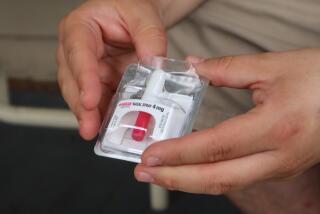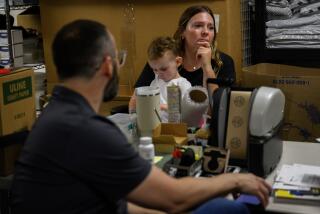Meth War Hitting Close to Home--at Local Pharmacy
Southern California is taking its war on methamphetamines to an unlikely front--the counter at your neighborhood pharmacy.
As the region tries to shake its reputation as the methamphetamine capital of America, an array of localities is cracking down on a source of one of the illicit drug’s key ingredients--over-the-counter cold medicines.
The San Gabriel Valley city of Covina joins Riverside, Orange and San Diego counties in considering measures to ban large purchases of some medicines; similar laws have been enacted by San Bernardino County and the city of Chino.
The cold medicine laws are being proposed at such a clip that the California Grocers Assn. and other trade groups held a special conference Thursday in Ontario on how to deal with these statutes.
The legislative efforts are aimed at some customers who have been hauling dozens of packs of cold medicine from stores, then tossing them into a noxious stew to make methamphetamine. Many cold medicines contain a key ingredient in the homemade drug--also known as crank, speed or ice--which is eclipsing cocaine as the most popular narcotic in the nation.
Law enforcement officers in Orange County have long been aware that meth lab operators were buying up large quantities of a cold medicine ingredient for their illegal operation.
Carl Armbrust, the prosecutor in charge of the Narcotics Enforcement Team at the Orange County district attorney’s office, said pseudoephedrine buyers often pose as doctors or drug distributors.
Methamphetamine is mostly manufactured in Southern California, inside makeshift labs hidden in motels, mobile homes and subdivisions, which spew toxic fumes and sometimes explode, killing dealers and innocents alike.
As meth’s popularity grows unabated, the labs are migrating east, and authorities hope that the cold medicine restrictions will follow.
“We want to run them out of the state of California and make it so inconvenient for them they have to go elsewhere,” said Walt Allen, a Covina councilman and state drug agent. “And then hopefully we want to continue to chase them across the country and make life impossible for them by shutting down easy access to the chemicals.”
The man who got the ball rolling, former Chino Police Chief Richard Sill, was inspired by local drug dealers’ behavior. “They literally set up shop in a hotel across the street from the Drug Emporium and then blew themselves and the lab up,” he said.
The regulations are only the latest effort to stem the growing methamphetamine problem at its source--the legally available chemicals used to make the drug.
The sales of certain chemicals--even the beakers used to store them--are tracked by law enforcement. And bulk sales of over-the-counter cold medicines are controlled under federal law at the wholesale level. Those laws deal with the distribution of thousands of pills and hundreds of bottles at a time and are intended to limit access to the key chemicals they contain.
*
At the retail level, local governments along with pharmaceutical companies and merchants are also hoping to cut into the raw material--pseudoephedrine, the chemical in most cold and allergy medications that is a key ingredient in methamphetamine. Over-the-counter products containing it include Sudafed, Cenafed, Chlor-Trimeton Non-Drowsy Decongestant, Drixoral Non-Drowsy Formula, Efidac/24 and PediaCare Infants’ Oral Decongestant Drops.
Without pseudoephedrine, or its sister compound ephedrine, which is also found in cold medicines, there is no meth--no prolonged high that can lead to jittery paranoia and hyperactive rushes, not to mention intense addiction.
“Basically it is like baking a chemical cake, and the pseudoephedrine is the flour,” Allen said.
For the past year, the Nonprescription Drug Manufacturers Assn., a trade group, has been sharing information on the problem with retailers and working on public service announcements to alert Americans to the dangers of methamphetamine.
At least one of the organization’s pharmaceutical company members has begun tinkering with the formulas of its product, trying to make it harder to extract pseudoephedrine, said Joe Doss, senior vice president of the association. “We’re trying to do what we can,” he said.
Doss added that over-the-counter sales account for a fraction of the pseudoephedrine used to make methamphetamine and that law enforcement should concentrate on other sources of supply.
Depending on the dosage, it could take 50 pills to make three grams of methamphetamine--not a huge amount, probably worth about $160 on the street, state drug agents say.
“Legitimate, over-the-counter medicines are not a significant part of the methamphetamine problem,” Doss said.
That’s true, authorities say. Although both large and small methamphetamine labs rely on pseudoephedrine, the big ones--which are typically hidden in the California deserts and produce the majority of the drug--use pseudoephedrine shipped from Mexico or through shady U.S. wholesalers. Federal laws passed in 1996 are designed to track those transactions.
*
But it is the smaller and more numerous labs, concealed in populated areas and often staffed by cookers who are themselves wired on methamphetamine, that rely on over-the-counter drugs. Authorities say these so-called “Beavis and Butt-head” labs are more of a public safety threat because they are in populated areas, and the cold medicine laws are intended to attack them.
One of the more notorious of these labs came to public attention in Riverside County in 1996, when three children were killed in an explosion while their mother was cooking methamphetamine in the kitchen.
But other labs are sprinkled throughout Southern California, sometimes in the most unlikely places.
“Next time you are sleeping in a hotel or motel you might wonder if someone is cooking dope next door to you,” Allen said. “We’ve even had people in mobile homes cooking while [driving] down the road.”
And these labs, authorities say, are running on the dozens of packs of cold medicine the cookers scoop up in drugstores.
In Covina, one pharmacist, who spoke on condition of anonymity, said questionable customers have hoarded cold medicine. “I have seen people trying to buy armfuls of the stuff,” he said.
*
The corporate chains began to tackle the problem last year, when giants such as Wal-Mart and Costco implemented controls on sales of over-the-counter pseudoephedrine drugs. In partnership with the Drug Enforcement Administration, Wal-Mart programmed its checkout scanners last year to allow only three to six packages per customer and has discontinued sales of one brand of bottled cold tablets that was highly popular with meth labs.
“We wanted to be sure Wal-Mart was not becoming a source for illicit drugs,” company spokesman Les Copeland said. “We know that Wal-Mart alone cannot win the war against drugs, but we hope it’s a step in the right direction.”
That is why Chino adopted what is believed to be the nation’s first restriction on retail sales of over-the-counter medicines in April, on the recommendation of a local pharmacist who told the police chief about the sudden popularity of certain cold remedies.
San Bernardino County as a whole adopted a similar law in November, and advocates are hoping to pass such a measure in Covina, where the City Council is expected to consider it next month.
The proposed laws are confined for now to Southern California.
“As someone who’s had sinus surgery recently and has needed these medicines, I believe it is worth a little bit of inconvenience to the consumer to protect our neighborhoods and children,” Covina City Manager Francis Delach said.
The California Grocers Assn. opposes the Covina ordinance, which would limit transactions to two blister packs per customer per day.
More to Read
Sign up for Essential California
The most important California stories and recommendations in your inbox every morning.
You may occasionally receive promotional content from the Los Angeles Times.











